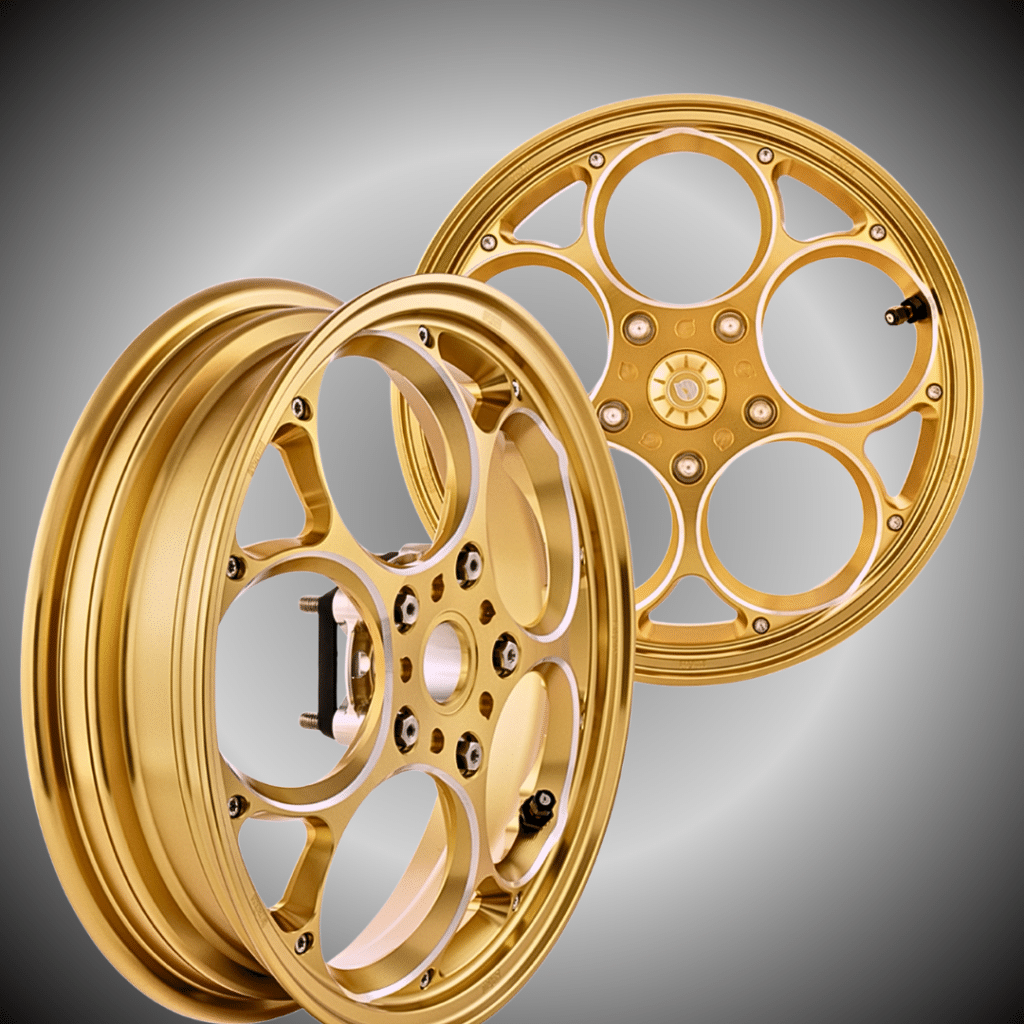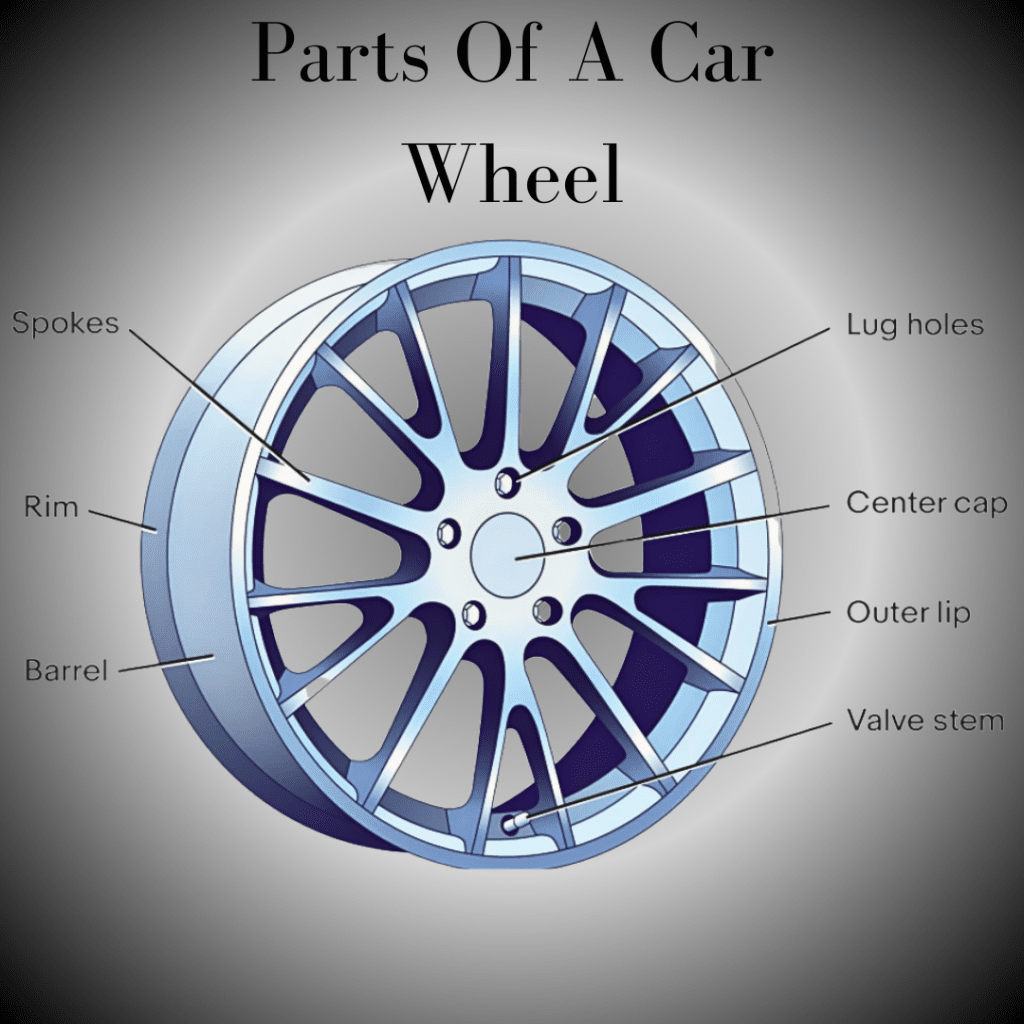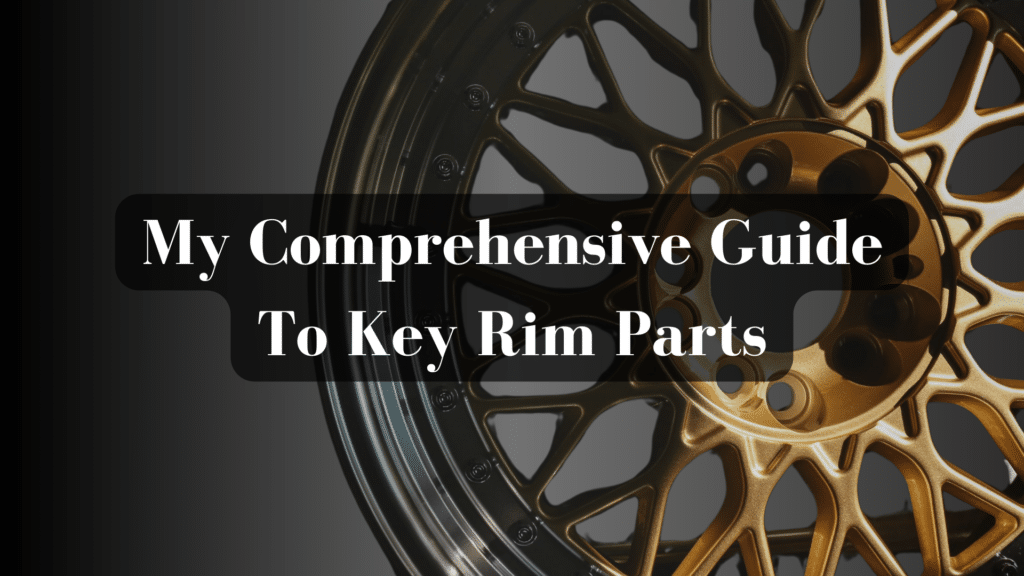Car rims are more than shiny metal parts—they’re vital for your safety and the handling of your car on the road.
But with so many rim parts to keep track of, it’s easy to feel lost.
I’ve been an auto mechanic for 15 years, and I’ll explain everything you need to know about rim components.
In this guide, you’ll learn:
- What each part does and why it matters
- How to spot signs of wear and damage
- When to repair vs replace rim components
By the end of this article, you’ll understand exactly what keeps your wheels turning and how to check if your rims are in good shape.
I’ve fixed thousands of rims over the years and am here to share what works.
Rim Parts and Their Functions

Let me walk you through the vital parts of your car’s rim.
Each piece plays a specific role in keeping your wheels working properly and safely.
1. Rim Lip
The outer edge of the rim holds the tire in place.
Think of it as a shelf that keeps the tire from slipping off.
When I inspect rims, I always check the lip first since it experiences the most stress from daily driving.
Features:
- Forms a tight seal with the tire
- It helps prevent air leaks
- Takes the first hit from curbs and potholes
2. Spokes
These are the arms that run from the center to the outer edge.
They hold everything together and distribute the weight of your car.
Good spokes can keep a rim strong for many years.
Features:
- Come in different shapes and patterns
- Transfer force from the road to your car
- Make the rim lighter while keeping it strong
3. Hub Mounting Surface
This is where your rim connects to your car.
For a safe fit, it needs to be perfectly flat.
I check this spot carefully because even small damage can cause wobbling.
Features:
- It has bolt holes for mounting
- Must stay clean and rust-free
- Needs precise alignment
4. Valve Hole
This small but important hole allows you to put air in your tires.
You might not think much about it, but without it, you won’t be able to keep your tires filled.
Features:
- Sized to fit standard valve stems
- Usually has a rubber grommet
- It needs to stay clean and clear
5. Drop Center
The middle part of the rim dips down to make putting tires on easier.
It’s like a valley that allows the tire to stretch during mounting.
Features:
- It makes tire changes possible
- It helps center the tire
- Adds strength to the rim design
6. Safety Hump
This small ridge inside the rim helps keep your tire in place if you lose air pressure.
It’s a backup safety feature I’m always glad to see.
Features:
- Acts as a tire retention system
- Prevents complete tire separation
- Provides extra security in emergencies
7. Bead Seat
This is where your tire sits on the rim.
It needs to be smooth and even for a good seal.
I always clean this area well during tire changes.
Features:
- Creates an airtight seal
- Supports the tire’s weight
- Must stay free of damage
8. Bolt Holes
These holes let you bolt the rim to your car.
They’re precisely sized and spaced for your specific vehicle model.
Features:
- Match your car’s bolt pattern
- Include special seats for lug nuts
- Must stay round and clean
9. Center Bore
This center hole fits over your car’s hub.
It helps center the wheel and supports proper weight distribution.
Features:
- Sized to match your car’s hub
- Helps eliminate vibration
- Must stay perfectly round
Why Are Rim Parts Important for Safety?

As a mechanic, I’ve seen what can happen when rim parts fail.
Let me explain why these components matter so much for your safety on the road.
1. Stability and Control
Your rims connect your tires to your car.
When all rim parts work together properly, they help keep your car stable and under control.
But if just one part isn’t right, you might notice:
- Your steering wheel is shaking
- The car pulling to one side
- Odd noises when turning
- Trouble keeping straight on highways
2. Braking Safety
Good braking depends on strong rim parts.
I’ve tested thousands of cars, and I know that damaged rims can make brakes less effective.
When you press your brake pedal, every second counts.
Weak or bent rim parts can add several feet to your stopping distance.
3. Weight Support
Your rim parts carry your car’s entire weight.
Each part needs to be in good shape to handle:
- The force of turning corners
- The impact of bumps and potholes
- The stress of highway speeds
- The pressure of quick stops
4. Warning Signs
I tell my customers to watch for these safety red flags:
- Visible cracks in any rim part
- Air leaking around the rim
- Unusual tire wear patterns
- Vibration in the steering wheel
5. Real Consequences
I’ve fixed many cars after rim failures.
The results can be serious:
- Sudden tire deflation
- Loss of control at high speeds
- Uneven brake wear
- Damage to other car parts
Remember: your rims aren’t just about looks.
They’re a crucial safety system that needs all parts working perfectly together.
When you maintain your rim parts properly, you’re protecting yourself and others on the road.
Key Features of a High-Quality Rim
After checking thousands of rims in my shop, I know what makes some stand out.
Here are the five most important features of a quality rim.
1. Strong Materials
The best rims use materials that last.
I recommend aluminum alloy rims because they:
- Stand up to daily wear and tear
- Don’t rust like steel rims
- Can take hits from road debris
- Stay strong in hot and cold weather
2. Smart Weight Balance
Good rims spread weight evenly.
This matters because:
- Your car handles better on turns
- Tires wear more evenly
- You feel less vibration
- Your car uses less fuel
3. Proper Fit Design
Quality rims have exact measurements for your car.
When I install rims, I check that:
- The bolt pattern matches perfectly
- The center bore fits snugly
- The offset is correct for your model
- The width works with your tires
4. Clean Finish
A good finish isn’t just about looks.
From my experience:
- It stops corrosion
- Makes cleaning easier
- Protects against road salt
- Helps spot damage early
5. Heat Management
Top rims handle heat well. This means:
- Your brakes work better
- Parts stay strong longer
- Tires keep their proper shape
- You get better performance
Remember: paying a bit more for a rim with these features often saves money in the long run.
You’ll replace them less often, and they’ll help other parts of your car last longer, too.
Warning Signs of Worn or Damaged Rim Parts
1. What You Can Feel
While driving, pay attention to these signals:
- Shaking in your steering wheel
- A bumpy feeling, even on smooth roads
- Your car pulling to one side
- New sounds when turning or braking
2. What You Can See
I tell my customers to look for these visible signs:
- Cracks near bolt holes or spokes
- Dents or bends in the rim edge
- Rust spots or bubbling paint
- Uneven tire wear patterns
3. Air Pressure Problems
Watch out for these tire pressure signs:
- Needing to add air more often than usual
- Hearing a hissing sound near the rim
- One tire always being lower than the others
- Bubbles forming where the tire meets the rim
4. Signs While Parked
Check these things when your car is stopped:
- Spots where the rim looks bent or dented
- Missing chunks of metal
- Rough or discolored patches
- Loose-feeling wheels
5. Time to Call a Pro
Get help right away if you notice:
- Deep scratches that catch your fingernail
- Wobbling wheels at any speed
- Squealing sounds when turning
- Brake pedal vibration
When to Buy vs. Repair Your Rim Parts
After fixing rims for 15 years, I’ve learned when to repair and when to replace.
Let me help you make the right choice for your situation.
1. When Repairs Make Sense
I often recommend repairs for these issues:
- Small scratches or scuffs
- Minor bends from curb hits
- Light corrosion spots
- Cosmetic damage to the finish
These repairs usually cost $50-150, saving you money compared to new rims.
2. When to Buy New Rims
In these cases, I always tell customers to buy new:
- Cracks of any size
- Severe bends or dents
- Heavy rust damage
- Damaged bolt holes
- Worn-out bead seats
Safety comes first – some damage just isn’t worth fixing.
3. Money-Saving Tips for Repairs
Here’s what I tell my customers to save cash:
- Fix small problems early
- Clean and seal rims regularly
- Watch for sales on repair services
- Consider used parts for older cars
4. Smart Buying Tips
When you need new rims, try these tips:
- Compare prices at multiple shops
- Look for package deals with tires
- Check local junkyards for matching sets
- Buy standard sizes (they cost less)
5. Getting Your Money’s Worth
From my experience:
- Good repairs can last years
- Quality new rims often last 7-10 years
- Cheap repairs often need redoing
- Poor-quality new rims may fail quickly
How to Maintain Your Rim Parts Effectively
Let me share some simple steps I recommend to my customers to keep their rim parts in good shape.
These tips come from years of seeing which maintenance habits really work.
1. Regular Cleaning
Clean your rims every few weeks:
- Use plain soap and water
- Avoid harsh chemicals
- Dry them completely
- Pay extra attention to crevices
2. Quick Checks
I suggest these quick checks each month:
- Look for new scratches or dents
- Check all lug nuts are tight
- Feel for rough spots
- Watch for signs of rust
3. After Rough Roads
Check these things after hitting bumpy roads:
- Walk around and look at each rim
- Listen for new sounds while driving
- Feel for any wobbles
- Check tire pressure
4. Seasonal Care
Do these tasks with each season change:
- Clean salt residue in winter
- Check for winter damage in spring
- Remove stuck debris in summer
- Protect against fall rain
5. Simple Protection Steps
These habits help prevent damage:
- Avoid deep puddles
- Park away from curbs
- Drive slowly over speed bumps
- Watch for potholes
6. Professional Care
See a mechanic when you notice:
- New vibrations
- Strange noises
- Uneven tire wear
- Steering problems
Remember: a few minutes of care each month can save hours of repair time later.
Good maintenance keeps your rims safe and helps them last longer.
Tips to Extend the Life of Your Rim Parts
1. Smart Driving Habits
Small changes in how you drive can protect your rims:
- Slow down before speed bumps
- Keep extra space from curbs
- Take wider turns around potholes
- Drive slower on rough roads
2. Tire Pressure Matters
I check tire pressure twice a month because:
- Right pressure protects rim edges
- Even pressure means less strain
- Low pressure can bend rims
- High-pressure risks damage
3. Regular Wheel Balance
Get your wheels balanced when you:
- Put on new tires
- Hit a big pothole
- Feel steering shake
- Notice uneven wear
4. Weather Protection
Different seasons need different care:
- Wash off road salt in winter
- Check seals in rainy weather
- Clean brake dust in summer
- Apply wax before winter starts
5. Basic Checks Save Money
These simple checks help spot problems early:
- Look at rims after car washes
- Listen for new sounds
- Feel for steering changes
- Watch how your car tracks
6. Park Smart
Where and how you park matters:
- Choose level spots
- Stay away from high curbs
- Avoid deep gravel
- Watch for oil spots
Conclusion
Taking care of your rim parts isn’t just about keeping your car looking good—it’s about staying safe on the road.
From my years of fixing cars, I know that small problems can turn into big ones if you ignore them.
Start checking your rims monthly.
Look for damage, listen for odd sounds, and feel for vibrations.
These simple checks take just a few minutes but can save you hundreds in repairs.
Good rim care means safer driving, longer-lasting parts, and better handling.
If you spot anything that doesn’t seem right, get it checked out.
Your local mechanic would rather prevent a problem than fix a broken rim.
Want to learn more?
Ask your mechanic to show you what to watch for during your next tire rotation.
Frequently Asked Questions
How Long Do Rim Parts Usually Last?
Quality rim parts typically last 7-10 years with proper care and normal driving.
Heavy off-road use or frequent curb hits can cut this time in half.
Can I Mix Different Rim Types on My Car?
No. Using different rim types can cause handling problems and uneven tire wear.
Always use matching rims on all wheels for safety.
What’s the Best Way to Clean Brake Dust Off Rims?
Use warm water and car soap with a soft brush.
Avoid harsh chemicals or metal brushes that can damage the finish.
Should I Repair a Leaking Rim or Buy a New One?
Small leaks from the bead area can often be fixed.
But if the rim has cracks or severe bends, replacement is safer.
Do Weather Conditions Affect Rim Life?
Yes. Salt, ice, and extreme temperatures can speed up rim wear.
Regular cleaning and protection help prevent weather damage.


